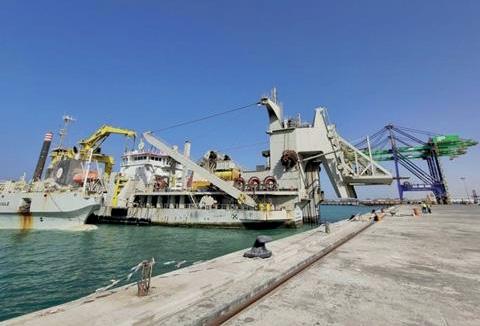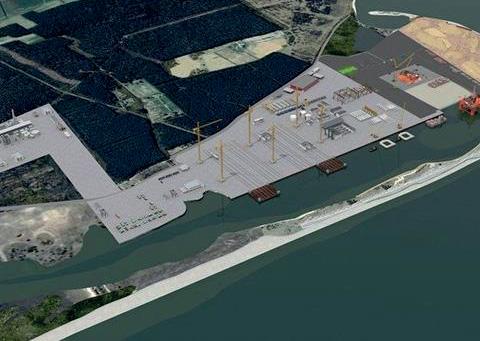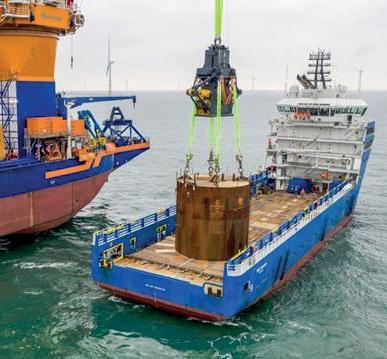
7 minute read
Planning pays
PLANNING PAYS IN WILLEM DE RUBROECK’S DEBUT
Belgian contractor Jan De Nul’s most powerful cutter suction dredger, the 41,346 kW Willem de Rubroeck, has successfully completed its maiden project in Mauritania
The Willem de Rubroeck was instrumental in delivering the new ARISE port terminal in the harbour at Nouakchott for the northwest African country. The vessel was required to work in large Atlantic Ocean swells dredging hard seabed and also worked near existing port infrastructure in shallow waters. Willem de Rubroeck worked in tandem on this project with Jan De Nul’s trailing suction hopper dredger James Cook.
Together the vessels deepened the access channel to the capital city’s port, as well as the port basin and alongside at the new ARISE port terminal. Willem de Rubroeck pre-cut the hard seabed which was then dredged by the James Cook with assistance from the barges Pinta, Boussole, L’Aigle, and Le Gurrier. A total of some three million m3 of hard soil was removed.
Willem de Rubroeck was designed to dredge hard, rocky soils in difficult sea and weather conditions which can adversely affect project planning and impact budgets. For a cutter suction dredger to work effectively the spud and cutter head must remain in the same position at all times. Jan De Nul made design adjustments to the spud carrier and the flexible suspension of the Willem de Rubroeck’s cutter ladder which allowed for greater movement of the vessel’s structure and absorbed vibrations, enabling work to continue in adverse conditions.
The spud carrier travelling cylinder was given a dynamic and active component , meaning the work spud in the spud carrier is suspended by shock absorbers. When forces on the spud become too great, the shock absorbers protect the spuds from becoming overloaded.
The cutter ladder moves up and down with the help of two winches. Unlike most cutter suction dredgers, where the ladder is attached by wire to the ladder gantry, the Willem de Rubroeck’s ladder suspension rests on air cushions. Vibrations are absorbed by the air cushions, reducing the risk of damage to the vessel. Willem de Rubroeck is capable of dredging to an impressive depth of 45m.
Pre-planning for the project included geological studies and analysis of long-term average wave conditions at the site to determine the most opportune start time.
8 The Willem de
Rubroeck was required to work in large Atlantic Ocean swells dredging hard seabed and also worked near existing port infrastructure in shallow waters
Dredging starts Ardersier Port transformation
Dredging works have started in Scotland which will enable the reopening of a repurposed Ardersier Port as Europe’s fi rst fully circular Energy Transition Facility.
In the 1970s Ardersier, a vast and currently unused port 14 miles east of Inverness, was one of the largest oil rig fabrication yards in the world, employing up to 4,500 workers. Covering an area of 162ha and with more than 1km of quayside, Ardersier is the largest brownfield port in the UK.
The port’s new owners have an agreement with floating offshore wind developer BW Ideol guaranteeing the latter exclusive access to the port for the manufacture of their concrete floating wind foundations.
The nine month, £20m dredging works will enable the creation of an oil rig decommissioning facility which will recycle

8 Ardersier is the largest brownfi eld port in
the UK, providing an area of 162ha served by 1km of quayside
oil rigs of the past to make the foundations for future floating offshore windfarms. Some 2.5 miilion m3 of sand dredged to reopen the port will be beneficially reused in an onsite concrete production plant.
Decommissioning of old oil rigs is expected to provide some 100,000 tonnes of scrap steel yearly, which will be recycled in a £300 million ‘green’ steel mill utilising an electric arc furnace powered by renewable energy, the UK’s first new steel mill in half a century. The recycled steel produced will be used as reinforcement for concrete floating wind foundations. The entire scheme will contribute substantially to an offshore wind market which is predicted to deliver 29,000 jobs and £43.6 billion to the UK economy by 2050.
“At Ardersier we can lead the UK’s Green Industrial Revolution by using circular eceonomy practices to deliver new low carbon infrastructure built on the byproducts of our oil and gas past”, said Ardersier Port owner Steve Regan.
WORLD’S FIRST INLINE ACTIVE HEAVE COMPENSATOR
With 62 hours of rigorous off shore testing, tech scale-up Seaqualize successfully completed off shore trials for its inline Active Heave Compensator (iAHC), the ‘Delta600’
Together with testing partners Van Oord and nautical research institute MARIN, the off shore lifting tool was tested for fi xed-to-fl oating, fl oating-to-fi xed and fl oatingto-fl oating transfers of 300mT loads. The Delta600 is now DNV certifi ed and ready for work.
Seaqualize started developing the world’s first iAHC: a tool specifically designed for heavy lift, in-air load control in late 2019. The tool can balance and transfer loads of up to 600mT in mid-air, while the barge or crane vessel is heaving up and down in heavy seas of up to Hs2.5m.
INCREASED UPTIME
This functionality is of great benefit during offshore wind turbine installations or when lifting delicate loads to and from floating supply vessels or barges. By engaging the Delta, the operational time for installation contractors greatly increases, especially in the hard-to-work winter, autumn or spring seasons. It offers contractors greater planning flexibility, and lifting crew a higher level of control, safety and efficiency. With the worldwide increase in demand in the offshore wind sector, increased capacity and efficiency is greatly needed. In the wider offshore community, perfectly controlled lifts are equally essential to safe, timely and efficient operations.
During the trials, the Delta600 lifted a test weight to and from the floating supply vessel REM Trader, using Van Oord’s jack-up crane vessel Aeolus in both jacked and floating configuration. These floating-to-floating and floating-to-fixed lifts were operational tests of typical challenges in the offshore wind industry: installing turbine components using a floating vessel, or picking up components from a floating supply vessel. Such ’feeder barge’ operations are essential in for example the US wind market. Transferring the most delicate parts of a wind turbine offshore is new to the market, and such operations comprise demanding lifting conditions and a new set of tools.
Wouter Dirks, Innovation Manager at Van Oord said: “The offshore tests showed that the unique technology in the Delta will enable controlled offshore lifts during challenging feeder barge operations”.
5CM ENVELOPE
During the tests, several very gentle set downs and quick liftoffs were performed. MARIN observed that the tool is able to control the load within an envelope of 5cm, with minimal accelerations and dynamic crane forces. Liftoffs where performed with a solid 90% of the load already in the hook of the crane before liftoff, while still fully compensating all waves. This significantly reduces impact loads on the load, crane and rigging and results in a controlled and stable liftoff. Finally, the tool showed off its “follow-mode”, where the test weight could actively match all heave motions of the target vessel, to further minimize set-down impact for floating to floating set downs.
This offshore trial was also the last step in full DNV product certification as a standard offshore lifting tool. The research project was executed with a grant from the Ministry of Economic affairs of the Netherlands, and included Dutch research agency TNO besides the offshore testing partners MARIN, Van Oord Offshore Wind and Seaqualize.

8 The world’s fi rst
inline Active Heave Compensator (Delta600)
NEXT STEPS
600mT Lifting may seem like a lot (e.g. it’s equivalent to 3 Boeing 747’s), but offshore wind turbine sizes are growing explosively, thus requiring ever bigger lifting tools for still very delicate components. Currently Seaqualize is designing the next version, the Delta1000, equipped for all next generation wind turbine components. Further conceptual improvements include the addition of single lifting points for quick-connect systems, and smart controlled tugger winches for supreme control in the horizontal plane. At the same time, the company will further develop its offshore operational support capabilities, by deploying the Delta600 in the field.




